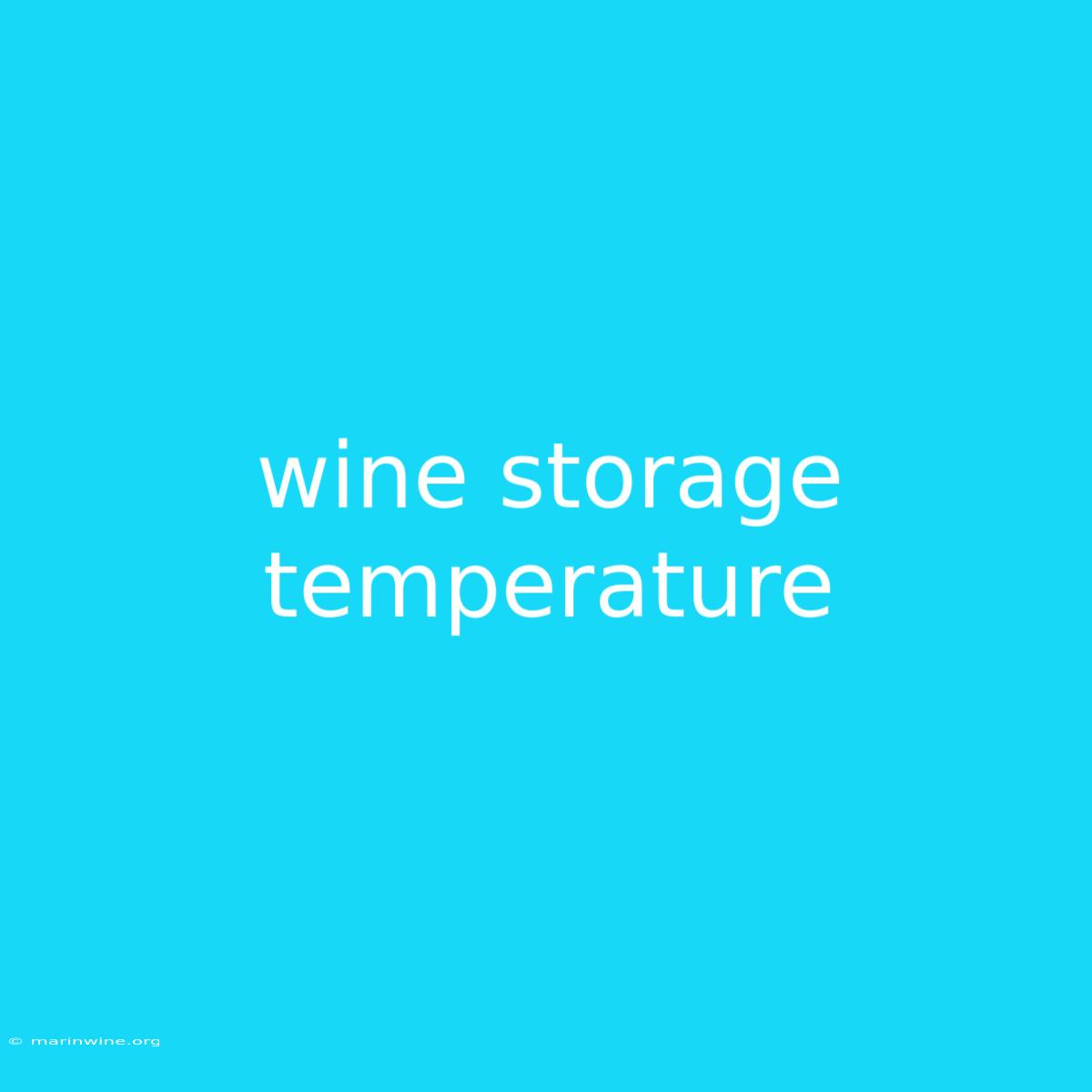Wine Storage Temperature: The Key to Preserving Your Precious Bottles
Have you ever wondered what the ideal temperature is for storing your wine collection? It's a crucial factor in preserving the delicate flavors and aromas of your favorite bottles. Storing wine at the right temperature can make the difference between a delightful sip and a disappointing experience.
Why It Matters
Wine storage temperature is essential for maintaining the quality of your wine over time. The perfect temperature keeps the wine aging correctly, preventing spoilage and oxidation. This includes factors like:
- Slowing down the aging process: Too high a temperature speeds up the aging process, leading to a loss of flavor and aroma.
- Preventing oxidation: Exposure to air can cause oxidation, leading to a stale, vinegar-like taste.
- Maintaining optimal conditions: Fluctuating temperatures can cause the wine to expand and contract, weakening the cork and potentially leading to leakage.
Key Takeaways of Wine Storage Temperature
| Factor | Effect | Ideal Temperature Range |
|---|---|---|
| Temperature | Maintains optimal aging and prevents oxidation | 53-59°F (12-15°C) |
| Humidity | Prevents cork dryness and potential leaks | 65-75% |
| Light | Prevents degradation of flavor and color | Avoid direct sunlight or fluorescent light |
| Vibration | Reduces the formation of sediment and enhances clarity | Minimal vibration |
Wine Storage Temperature
Introduction: Storing wine at the ideal temperature is vital for its long-term preservation. While a cellar might seem ideal, even your home can provide suitable conditions with a bit of planning.
Key Aspects:
- Ideal Temperature Range: The ideal temperature for storing most wines is between 53-59°F (12-15°C). This range ensures the wine ages slowly and consistently, preserving its flavors and aromas.
- Consistency: Consistency is key when it comes to wine storage temperature. Fluctuations can negatively impact the wine's quality, so try to maintain a stable environment.
- Location: Choose a cool, dark, and dry location for your wine storage. Basements, closets, or even designated wine cabinets can provide suitable conditions.
Further Analysis:
- Red Wine: Red wines generally benefit from slightly higher temperatures than whites and rosés, around 55-60°F (13-15°C).
- White Wine: White wines and rosés are best stored at cooler temperatures, ideally between 53-57°F (12-14°C).
- Specific Wines: Some wines, like dessert wines or fortified wines, may require different storage conditions.
Information Table:
| Wine Type | Ideal Storage Temperature (°F) | Ideal Storage Temperature (°C) |
|---|---|---|
| Red Wine | 55-60 | 13-15 |
| White Wine | 53-57 | 12-14 |
| Rosé Wine | 53-57 | 12-14 |
| Sparkling Wine | 45-50 | 7-10 |
FAQ for Wine Storage Temperature
Introduction: Here are some frequently asked questions about wine storage temperature.
Questions:
- Q: Can I store wine in my refrigerator? A: While a refrigerator can maintain a cool temperature, it's not ideal for long-term wine storage. The humidity levels are typically too high, and the constant exposure to cold can damage the wine.
- Q: What about storing wine in a wine rack? A: Wine racks are great for displaying your collection, but they often lack proper temperature control. They are best suited for short-term storage or serving wines.
- Q: How do I know if my wine has been stored incorrectly? A: Signs of incorrect storage include a cloudy appearance, a "cooked" or overly fruity aroma, and a flat or muted taste.
Summary: The FAQ section highlights that refrigerators are not suitable for long-term wine storage, and wine racks are best for short-term storage or display.
Tips for Wine Storage Temperature:
Introduction: Here are some helpful tips for maintaining the ideal temperature for your wine collection.
Tips:
- Use a Wine Cellar or Cooler: If you're serious about wine storage, investing in a dedicated wine cellar or cooler can provide consistent temperature and humidity control.
- Choose a Cool Location: Find a cool, dark, and dry location in your home, such as a basement or closet.
- Monitor the Temperature: Use a thermometer to regularly check the temperature of your storage area.
- Store Wine on its Side: Storing wine on its side keeps the cork moist, preventing it from drying out and potentially leaking.
- Avoid Vibration: Keep your wine storage area away from sources of vibration, such as appliances or heavy machinery.
Summary: These tips highlight the importance of choosing the right storage location, monitoring the temperature, and storing wine on its side to maintain optimal conditions.
Summary by Wine Storage Temperature
This article explored the importance of maintaining the ideal temperature for storing your wine collection. The ideal temperature range is between 53-59°F (12-15°C), ensuring the wine ages slowly and consistently, preserving its flavor and aroma. Factors like consistency, location, and humidity are crucial to consider, and a dedicated wine cellar or cooler can provide optimal conditions. By following these tips, you can preserve your precious bottles and ensure that your next sip is a delightful experience.
Closing Message: By understanding the importance of wine storage temperature and implementing these tips, you can ensure your wine collection remains in peak condition, ready to be enjoyed for years to come. Remember, patience is key when it comes to wine, and with proper care, your investment will continue to mature and reward your palate.

